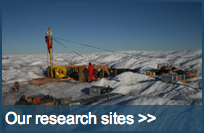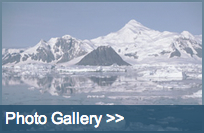Main tasks within ice2sea: Programme coordination (WP1), host to the Programme Office, involvement in WPs 2,3,5, and 6.
The British Antarctic Survey (NERC-BAS) is a component of the United Kingdom’s Natural Environment Research Council.
BAS’s mission is to undertake a world-class programme of scientific research, survey and long-term observations addressing key issues of global or fundamental importance requiring access to the Antarctic or related regions. BAS is based in Cambridge, and has, for ~ 60 years, undertaken the majority of Britain’s scientific research on and around the Antarctica. It now employs 400 staff, and supports three stations in Antarctica. The NERC-BAS research programme is planned on a five-year timetable.
The current programme is called Polar Science for Planet Earth, 2010-2015. The programme comprises a suite of six programmes complemented by independent research activities. In addition, the Antarctic Funding Initiative provides access to Antarctica for the UK university community. The BAS mission statement allows for involvement in Arctic activities, especially where they enhance understanding of Antarctic issues.
Staff members: Prof. David G. Vaughan, Dr Robert J Arthern, Dr R C A Hindmarsh, Dr H Pritchard, Dr Nick Barrand, Dr Rosie Williams, Dr Giesela Heiss.
David Vaughan has worked as a glaciologist since 1985 and is now a Principal Investigator at British Antarctic Survey, where he has led the core research programme in ice sheets and sea-level rise since 1999. His current programme, Glacial Retreat in Antarctica and Deglaciation of the Earth System (GRADES) employs 20 full-time researchers, covering a wide range of scientific disciplines from marine geophysics and quaternary geology, to numerical modelling and remote-sensing. His own research has focused on the Antarctic ice sheet and it’s response to climate change, but has covered issues in remote-sensing, climate and geophysics. DGV has led several multi-national programmes (See Section 2.1), and eight remote field campaigns in Antarctica. He was a lead author for Working Group II of the IPCC, Third Assessment Review, and a coordinating lead author during the Fourth Assessment Review. He is Honorary Professor in the School of Environment and Society, at University of Swansea (Wales), where he teaches a course on science, the media and policy-making.
Selected references:Anisimov, O. A., D. G. Vaughan et al. (2007), Chapter 15 – Polar Regions (Arctic and Antarctic), in Climate Change 2007: Impacts, Adaptation and Vulnerability. Fourth Assessment Report – Intergovernmental Panel on Climate Change, edited by M. L. Parry, et al., pp. 653-685, CUP, Cambridge, UK.
Pritchard, H., and D. G. Vaughan (2007), Widespread acceleration of tidewater glaciers on the Antarctic Peninsula, J. Geophys. Res., 112, doi:10.1029/2006JF000597.
Vaughan, D. G., and J. R. Spouge (2002), Risk estimation of collapse of the West Antarctic ice sheet, Clim. Change, 52, 65-91.
Vaughan, D. G. (2005), How does Antarctica affect sea level? Science, 308, 1877-1878.
Vaughan, D. G. (2006), Recent trends in melting conditions on the Antarctic Peninsula and their implications for ice-sheet mass balance, Arctic, Antarctic and Alpine Research, 38, 147-152.
Vaughan, D. G., and R. J. Arthern (2007), Why is it so hard to predict the future of ice sheets? Science, 315, 1503-1504.
Vaughan, D. G., et al. (1999), Reassessment of net surface mass balance in Antarctica, J. Clim., 12, 933-945.
Vaughan, D. G., et al. (2006), New boundary conditions for the West Antarctic ice sheet: Subglacial topography beneath Pine Island Glacier, Geophys. Res. Let., 33, L09501, doi:09510.01029/02005GL025588.
Vaughan, D. G., and C. S. M. Doake (1996), Recent atmospheric warming and retreat of ice shelves on the Antarctic Peninsula, Nature, 379, 328-331.
Vaughan, D. G., et al. (2003), Recent rapid regional climate warming on the Antarctic Peninsula, Clim. Change, 60, 243-274.
Rob Arthern is an expert on the application of data assimilation methods to ice sheets. He has developed and implemented a scheme for the optimal estimation of the shape and flow of large ice sheets, such as Greenland and Antarctica. The method can provide an analysis of the current state of the ice sheet, and a short-term forecast extending several decades into the future. He has experience of ice-sheet modelling, data assimilation, computational methods for large-scale inverse problems, remote-sensing of ice sheets using radar altimetry, and has mapped Antarctic snow accumulation using observations from satellites and from the field.
Selected references:
Vaughan D. G. and Arthern R. J., Why is it hard to predict the future of ice sheets? Science 315 (5818), 1503-1504, 2007.
Arthern R. J. and Hindmarsh R.C.A., Determining the contribution of Antarctica to sea-level rise using data assimilation methods. Philosophical Transactions of the Royal Society of London, Series A, 364, No. 1844, 1841-1865, 2006.
Arthern R. J., D. P. Winebrenner, and D. G. Vaughan, Antarctic snow accumulation mapped using polarization of 4.3-cm wavelength microwave emission, J. Geophys. Res., 111, D06107, doi:10.1029/2004JD005667, 2006.
Arthern, R. J., and R. C. A. Hindmarsh, Optimal estimation of changes in the mass of ice sheets, J. Geophys. Res., 108 (F1), 6007, doi:10.1029/2003JF000021, 2003.
Richard Hindmarsh is primarily known as an ice-sheet modeler, he graduated in Environmental Sciences from UEA, and did his PhD on modelling glacial erosion at Durham University. After post-docs at UEA and Edinburgh, he moved to NERC-BAS in 1991. Over the past two decades, a major concern of ice-sheet modellers has been understanding of the role of ice-sheets in the global climate system with an emphasis on their sea-level impacts. Ice-sheets are increasingly seen as being highly dynamic flows which couple strongly with their substrate through the basal hydrology. His research uses combinations of mathematical and numerical techniques which aim to solve scientific issues; some of these are quite theoretical, for example the characterisation of marine ice-sheet instabilities, some considers data assimilation, and some of the work addresses generalised field observations, for example glacial geomorphological features and some consider specific sites.
Selected references:
Hindmarsh, R. C. A. (2006), “Stress gradient damping of thermoviscous ice flow instabilities”, J. Geophys. Res., 111, B12409, doi:10.1029/2005JB004019.
Hindmarsh, R.C.A., G.J-M.C. Leysinger Vieli, M.J. Raymond and G.H. Gudmundsson, (2006), “Draping or Overriding: The Effect of Horizontal Stress Gradients on Internal Layer Architecture in Ice-Sheets” J. Geophys. Res., 111, F02018, doi:10.1029/2005JF000309.
Siegert, M.J, R. Hindmarsh, H. Corr, A. Smith, J. Woodward, E.C. King, A.J. Payne, I. Joughin (2004) “Subglacial Lake Ellsworth: a candidate for in situ exploration in West Antarctic?”,Geophysical Research Letters, 31, L23403, doi:10.1029/2004GL021477.
Hindmarsh, R.C.A. (2004) “A numerical comparison of approximations to the Stokes equations used in ice-sheet and glacier modelling”, J. Geophys. Res. 109_F01012), doi:10.1029/2003JF000065
Hindmarsh, R.C.A. (2004) “Thermoviscous stability of ice-sheet flows”, J. Fluid. Mech,502, p.17-40.
Hamish Pritchard is a glaciologist, specialising in remote sensing, geographic information systems and field geophysics. Recent focus on: 1) field radio echo sounding surveys for reconstruction of ice divide history; 2) radar remote sensing of glacier flow dynamics, particularly on the Antarctic Peninsula, and; 3) spaceborne laser altimeter measurement of glacier elevation change for the Antarctic and Greenland ice sheets. Outcomes from radio echo sounding comprise a centuries-long thinning and divide-migration record for an Antarctic Peninsula ice cap. Outcomes from dynamics measurements include the first comprehensive mapping of west Antarctic Peninsula glacier flow and the discovery of systematic regional acceleration. Altimetry study outcomes include the first comprehensive mapping of Greenland and Antarctic ice sheet elevation change to the coast, including major thinning of all former ice-shelf tributaries on the east and west Antarctic Peninsula. he will bring to the Ice2Sea project expertise in both field and remote data collection and analysis directly relevant to the project, as well as knowledge of the study region.
Selected references:
Vaughan, D.G., Corr, H.F.J, Smith, A.M., Pritchard, H.D. and Shepherd, A. (2007) Flow-switching and water piracy between Rutford Ice Stream and Carlson Inlet, West Antarctica. J.Glac. 54 (184), 41-48.
Pritchard H. D., D. G. Vaughan (2007), Widespread acceleration of tidewater glaciers on the Antarctic Peninsula, J. Geophys. Res., 112, F03S29, doi:10.1029/2006JF000597.
Pritchard, H.D. (2006) Review of ‘Polar remote sensing, Vol. II: ice sheets’. Journal of Glaciology 52 (178), 472.
Pritchard, H.D., T. Murray, A. Luckman, T. Strozzi, and S. Barr (2005), Glacier surge dynamics of Sortebræ, East Greenland, from Synthetic Aperture Radar feature tracking, J. Geophys. Res., 110 (F03005).
Rignot, E., Casassa, G., Gogineni, S., Kanagaratnam, P., Krabill, W., Pritchard, H., Rivera, A., Thomas, R., Turner, J. and Vaughan, D. (2005) Recent ice loss from the Fleming and other glaciers, Wordie Bay, West Antarctic Peninsula. Geophys. Res. Lett. V. 32, L07502.
Pritchard, H.D., Murray, T., Strozzi, T., Barr, S. and Luckman, A. (2003) Glacier surge-related topographic change derived from Synthetic Aperture Radar interferometry, Journal of Glaciology, 49, (166), 381-3


